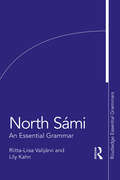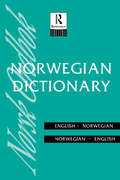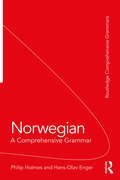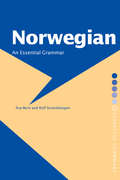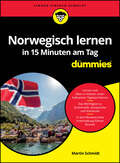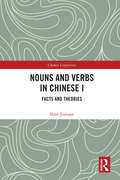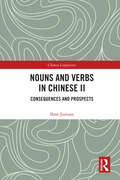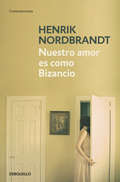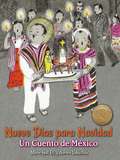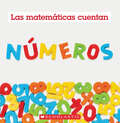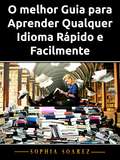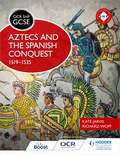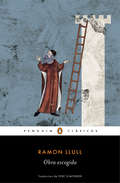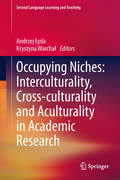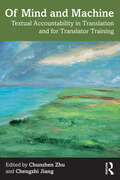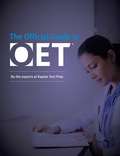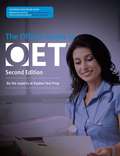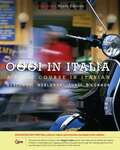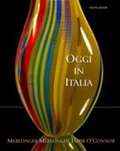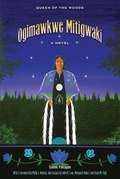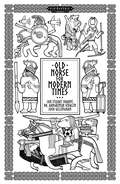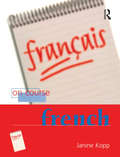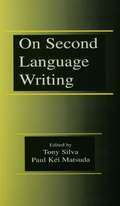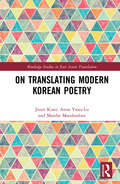- Table View
- List View
North Sámi: An Essential Grammar (Routledge Essential Grammars)
by Lily Kahn Riitta-Liisa ValijärviNorth Sámi: An Essential Grammar is the most up-to-date work on North Sámi grammar to be published in English. The book provides: a clear and comprehensive overview of modern Sámi grammar including examples drawn from authentic texts of various genres. a systematic order of topics beginning with the alphabet and phonology, continuing with nominal and verbal morphology and syntax, and concluding with more advanced topics such as discourse particles, complex sentences, and word formation. full explanations of the grammatical terminology for the benefit of readers without a background in linguistics. ? Suitable for linguists, as well as independent and classroom-based students, North Sámi: An Essential Grammar is an accessible but thorough introduction to the essential morphology and syntax of modern North Sámi, the largest of the Sámi languages.
Norwegian Dictionary: Norwegian-English, English-Norwegian (Routledge Bilingual Dictionaries)
by Forlang A.S. CappelensThis 2-way Dictionary is ideal for both linguists and the serious learner and user of Norwegian. Translations are supported by examples and entries are supported by an invaluable section covering aspects of Norwegian pronunciation and grammar.
Norwegian: A Study In Inflectional Morphology (Routledge Comprehensive Grammars)
by Philip Holmes Hans-Olav EngerNorwegian: A Comprehensive Grammar is a complete reference guide to modern Norwegian (the Bokmål standard). The Grammar is an essential source for the serious student of Norwegian, and for students of comparative linguistics. It is ideal for use in colleges, universities and adult classes of all types. The volume is organised to promote a thorough understanding of Norwegian grammar. It presents the complexities of Norwegian in a concise and readable form. Explanations are full, clear and free of jargon. Throughout, the emphasis is on Norwegian as used by present-day native speakers. An extensive index, numbered paragraphs, cross-references and summary charts provide readers with easy access to the information they require.
Norwegian: An Essential Grammar (Routledge Essential Grammars)
by Rolf Strandskogen Ase-Berit StrandskogenNorwegian: An Essential Grammar is a reference guide to the most important aspects of contemporary Norwegian as used by native speakers. The Grammar presents a fresh and accessible description of the language. Explanations are clear, free from jargon and often accompanied by exercises. The book gives a simple, step-by-step presentation of the grammatical systems of Norwegian and demonstrates and explains usages which have proved difficult for those learning the language in the past. It is clearly laid-out for easy reference making it accessible for those at a beginner/intermediate level. This is the ideal reference source for all learners, whether studying independently or in a class.
Norwegisch lernen in 15 Minuten am Tag für Dummies (Für Dummies)
by Martin SchmidtNur ein Viertelstündchen Norwegisch am Tag Sie wollen Norwegisch lernen, aber der Gedanke, stundenlang Vokabeln und Grammatik zu pauken, schreckt Sie ab? Dann ist dieses Buch genau das Richtige für Sie! In kurzen, auf 15 Minuten pro Tag begrenzten Lektionen bringt es Ihnen auf unterhaltsame Weise die norwegische Sprache näher. So erfahren Sie im Handumdrehen alles Wichtige über Grammatik, Aussprache und übliche Redewendungen. Durch regelmäßige Wiederholungsfragen können Sie Ihr Wissen testen und mithilfe des zum Download verfügbaren Audiomaterials auch die Aussprache üben. Nach nur drei Monaten beherrschen Sie die Grundlagen spielend. Sie erfahren Wie Sie in jeder Situation die richtigen Worte finden Mit welchen Redewendungen Sie brillieren Welche Wörter Sie nicht verwechseln sollten Wie Sie das Norwegische richtig aussprechen
Nouns and Verbs in Chinese I: Facts and Theories (Chinese Linguistics)
by Shen JiaxuanAs the first volume of a two-volume set that re-examines nouns and verbs in Chinese, this book proposes the verbs-as-nouns theory, corroborated by discussions of the nature and relationship between nouns and verbs in Chinese. Seeking to break free from the shackles of Western linguistic paradigms largely based on Indo-European languages and to a great extent inappropriate for Chinese, this two-volume study revisits the nature of nouns and verbs and relevant linguistic categories in Chinese to unravel the different relationships between nouns and verbs in Chinese, English, and other languages. It argues that Chinese nouns and verbs are related inclusively rather than in the oppositional pattern found in Indo-European languages, with verbs included in nouns as a subcategory. Preliminary to the core discussion on the verbs-as-nouns framework, the author critically engages with the issues of word classes and nominalization, as well as problems with the analysis of Chinese grammar due to the noun-verb distinction. Through linguistic comparisons, the following chapters look into noticeable differences between Chinese and English, the referential and predicative natures of nouns and verbs, the asymmetry of the two, and the referentiality of predicates in Chinese. The volume will be a must-read for linguists and students studying Chinese linguistics, Chinese grammar, and contrastive linguistics.
Nouns and Verbs in Chinese II: Consequences and Prospects (ISSN)
by Shen JiaxuanAs the second volume of a two-volume set that re-examines nouns and verbs in Chinese, this book investigates a wide range of linguistic phenomena in Chinese and other languages to substantiate the verbs-as-nouns theory proposed by the author.In an attempt to break free from the shackles of Western linguistic paradigms, which are largely based on Indo-European languages and to a great extent inappropriate for Chinese, the two-volume set unravels the different relationships between nouns and verbs in Chinese, English, and other languages. This volume begins by looking at the problematic issues surrounding complements and adverbials in Chinese in order to explain the multifunctional nature of Chinese word classes. It then makes extensive use of evidence from other languages to explore the typology and evolution of word classes, as well as the cultural roots underlying the distinction between indicative and non-indicative negation in Chinese. In addition, it elucidates the significance and functions of monosyllabic and disyllabic combinations and the phenomenon of markedness reversal, shedding light on the subjectivity of the Chinese word class system.The volume is an important contribution to the study of Chinese linguistics, Chinese grammar, and contrastive linguistics.
Nuestro amor es como Bizancio
by Henrik NordbrandtUna antología cronológica de Henrik Nordbrandt, uno de los poetas europeos contemporáneos más relevantes. Presentamos a los lectores españoles una antología cronológica de Henrik Nordbrandt, un poeta emparentado por temperamento con Cavafis o Auden. Sus poemas se distinguen sobre todo por su capacidad evocativa y sensual, su parentesco con las mejores letras de canciones, su variada temática de sabores orientales, su ciudado tratamiento de la intimidad y del amor, y su impresionante modernidad. Henrik Nordbrandt es autor de una de las aventuras poéticas más enriquecedoras, sensuales e iluminadoras de la segunda mitad del siglo XX. Ha recibido todos los premios de poesía existentes de su país natal, Dinamarca, así como el premio Nórdico de la Academia Sueca, más conocido como «pequeño Nobel», en 1990, o el prestigioso premio del Consejo Nórdico de Literatura en 2000. Reseña:«El poeta escandinavo más grande de su generación. Solo le resta ganar el Nobel de literatura.»Matías Néspolo, El Mundo
Nueve Días para Navidad: Un Cuento de México
by Marie Hall Ets Aurora LabastidaEl cuento de la emoción de una niña mexicana al acercarse la Navidad, desde su publicación original en 1960 y ganador la medulla Caldecott, ha sido disfrutada por generaciones de jóvenes lectores. Ceci no puede contener su alegría de poder participar, este año por privera vez, en las posadas, una de las fiestas navideñas tradicionales que se celebra en México por el correr de nueve días. Este año le toca a ella encabezar la procesión de velas que representa el viaje de María y José a Belén. Mamá la lleva al viejo mercado para elegir su propia piñata. Ceci queda deslumbrada con la colorida gama de opciones, y después de haber elegido su favorita, tiene dudas sobre el destino de su piñata una vez que la posada se lleve a cabo. <P><P> Con ilustraciones evocadoras de la época navideña, este libro se ha convertido en un clásico internacional. “El niño más pequeño, será totalmente transportado por esta historia”, comentó The Atlantic, y lectores de toda eda quedarán encantados del punto de vista de una niña de la cultura mexicana.
Números (Math Counts, New and Updated)
by Henry PluckroseUna serie de libros para introducir a los lectores jovenes a conceptos matematicos fundamentales, ¡ahora en espanol!Estamos rodeados de numeros. Hay numeros en las casas y en los autos. Hay numeros en los telefonos y en el dinero. Con ejemplos del mundo real, fotografias convincentes y textos inspiradores, ¡esta es la introduccion perfecta al concepto matematico de "numeros" para los lectores mas jovenes!Sobre la serie: Publicada originalmente en los anos 90 y actualizada recientemente, esta revolucionaria serie superventas inicia a los ninos en el camino de aprender a comunicarse y razonar matematicamente.La base de las matematicas son las ideas, y estos libros se han desarrollado para que los ninos vean, hablen, toquen y experimenten con estas ideas. Las fotografias atractivas y el texto sencillo y directo, hacen de esta serie una herramienta perfecta para leer individualmente o en voz alta. Diez conceptos matematicos fundamentales, uno para cada libro de la serie, estan desarrollados de forma excelente, y ofrecen un apoyo curricular ideal. Esta serie es la mejor manera de iniciar el camino hacia el dominio de las matematicas.
O melhor Guia para Aprender Qualquer Idioma Rápido e Facilmente
by Sophia SoarezUm guia detalhado para aprender qualquer idioma de forma fácil e rápida Este guia irá ajudá-lo a aprender um novo idioma em uma semana. Ele vai te ensinar dicas e truques para se tornar um falante nativo do novo idioma. Baseado em fatos científicos, este livro lhe dirá como: - É a maneira mais fácil de aprender uma nova língua - Usar o tempo de forma eficaz - Se tornar um falante nativo - Aprender a pronúncia correta de um novo idioma - Posicionar a boca para ter a pronúncia correta - Memorizar palavras de um novo idioma - Se manter motivado - Melhorar o sotaque Se você quer aprender um novo idioma em uma semana e se tornar um falante nativo, então este livro é para você. --> Role até o topo da página e clique em adicionar ao carrinho para comprar instantaneamente Informações Legais: Esta autora e ou detentor(es) dos direitos não faz nenhuma reivindicação, promessas ou garantias em relação à exatidão, completude ou adequação do conteúdo deste livro, e se isenta expressamente de responsabilidade por erros e omissões no conteúdo. Este produto é apenas para uso de referência. Consulte um profissional antes de tomar medidas sobre qualquer um dos conteúdos encontrados no livro.
OCR GCSE History SHP: Aztecs and the Spanish Conquest, 1519-1535
by Richard Woff Kate JarvisExam board: OCR (Specification B, SHP)Level: GCSE (9-1)Subject: HistoryFirst teaching: September 2016First exams: Summer 2018An OCR endorsed textbookLet SHP successfully steer you through the OCR B specification with an exciting, enquiry-based series, combining best practice teaching methods and worthwhile tasks to develop students' historical knowledge and skills.> Tackle unfamiliar topics with confidence: The engaging, accessible text covers the content you need for teacher-led lessons and independent study> Ease the transition to GCSE: Step-by-step enquiries inspired by best practice in KS3 help to simplify lesson planning and ensure continuous progression within and across units> Build the knowledge and understanding that students need to succeed: The scaffolded three-part task structure enables students to record, reflect on and review their learning> Boost student performance: Suitably challenging tasks encourage high achievers to excel at GCSE while clear explanations make key concepts accessible to all> Rediscover your enthusiasm for source work: A range of purposeful, intriguing visual and written source material is embedded at the heart of each investigation to enhance understanding> Develop students' sense of period: Memorable case studies, diagrams, infographics and contemporary photos bring fascinating events and people to life
Obras escogidas
by Ramon LlullLos mejores libros jamás escritos. Penguin Clásicos conmemora, con esta edición de la Obra escogida, el septingentésimo aniversario de la muerte de Ramon Llull, el gran genio medieval de las letras catalanas. «Entre viña e hinojal,tomóme amor, Dios me hizo amary entre suspiro y llanto estar.» La obra de Ramon Llull es una de las más ricas y variadas de toda la literatura universal. Su producción comprende más de doscientos libros de muy distintos géneros y temáticas: poesía, novela, mística, ciencia, filosofía, lógica. Las leyendas que durante siglos vistieron y enmarañaron la figura de Llull, convirtiéndolo en un alquimista y un ocultista, no pudieron, sin embargo, ocultar quien es: ante todo y sobre todo, el primer gran escritor en catalán. Los escritos recogidos en este volumen, en mayúscula traducción del poeta Pere Gimferrer y precedidas por un prolijo estudio del padre Batllori, son solamente una muestra del genio y la sapiencia del no por nada llamado «el doctor iluminado». Así, Vida coetánea es un dictado autobiográfico y el Libro de maravillas la mejor de entre todas las novelas del escritor, mientras que el Árbol ejemplifical nos acerca al Llull más científico. Cierran el volumen dos largas poesías en edición bilingüe, Desconsuelo y el Canto de Ramon, auténticos itinerarios espirituales de este creador altísimo.
Occupying Niches: Interculturality, Cross-culturality and Aculturality in Academic Research
by Andrzej Łyda Krystyna WarchałThis book presents a collection of thematically focused articles addressing culture-specific features of academic communication, with a particular focus on communication conducted in English as an Additional Language and directed at multicultural audiences. It comprises papers arranged in four sections: Expert writers, Novice writers and readers, Conference participants, and Non-research academic genres. The book explicitly addresses and is centred upon the concept of a research niche understood as a space to be captured and populated, as a temporary location to move or grow out of in the course of individual professional development from novice to expert, and as a space to consciously reach beyond, delimited by one's linguistic, cultural, educational, and geopolitical background. Here the niche is approached as a frame of reference for discussion of what is culture-bound, culture-sensitive, and culture-free in the academic community and its practices.
Of Mind and Machine: Textual Accountability in Translation and for Translator Training
by Chengzhi Jiang Chunshen ZhuOf Mind and Machine provides a broad perspective on multi-level dialogic engagements between text and reader as seen from the use of language in presenting information to generate a discursive experience in various sociocultural settings.The book observes contexts such as national literature in translation, diplomatic speech events, visual-verbal inter-semiotic translation, second language learning, interpreter training, and computer-aided teaching of translation and bilingual writing. These present a unifying interest in textual accountability between form, function, and effect that has been examined from a dual perspective of rhetoric and pragmatics. The research embodies a significant prospect of integration of academic originality with technological innovation to advance language education in the present digital era. Theoretically well-founded, the book does not confine itself to a self-contained system of conceptions and methods. Instead, it demonstrates a rich variety of research possibilities in support of theorisation and education in the field of language and translation studies.This edited volume is primarily intended for advanced undergraduates, postgraduates, researchers, and teachers within the fields of language and translation, applied linguistics, and discourse analysis.
Official Guide to OET
by Kaplan Test PrepThe Official Guide to OET is the first and only guide book endorsed by the test maker (CBLA) and is designed to prepare students for the updated OET exam. Kaplan Test Prep, the world leader in test preparation since 1938, has authored this book incorporating key test-taking tips and strategies. The practice questions have been reviewed by CBLA to ensure they are true to the test.Get familiar with the exam to help you face the OET with confidence. Test-like Listening tracks, realistic practice questions, and additional online resources give you everything you need to succeed on the OET. This book is suitable for both self-study and classroom use.Tips and Practice1 full practice testOnline audio for Listening contentSkill-boosting activities for each of the subtests (Listening, Reading, Writing & SpeakingSelf-study tipsTest Day adviceExpert GuidanceWe know the test: The Kaplan team in conjunction with CBLA ensure our practice questions and study materials are true to the testKaplan's books and practice questions are written by experts who know students—every explanation is written to help you learnWe invented test prep—Kaplan (www.kaptestglobal.com) has been helping students for 80 years, and our proven strategies have helped legions of students achieve their dreams
Official Guide to OET (Kaplan Test Prep)
by Kaplan Test PrepThe Official Guide to OET is the first guide book endorsed by the test maker (CBLA) and is designed to prepare students for the updated OET exam. Kaplan Test Prep, the world leader in test preparation since 1938, has authored this book incorporating key test-taking tips and strategies. The practice questions have been reviewed by CBLA to ensure they are true to the test.Get familiar with the exam to help you face the OET with confidence. Test-like Listening tracks, realistic practice questions, and additional online resources give you everything you need to succeed on the OET. This book is suitable for both self-study and classroom use.To access your audio and online resources, first register online at kaptest.com/booksonline. Once you&’ve registered, access your audio and resources at kaptest.com/login or download the Kaplan Mobile Prep app on Google Play or the App Store for your Android or iOS deviceTips and Practice1 full practice testOnline audio for Listening contentSkill-boosting activities for each of the subtests (Listening, Reading, Writing & SpeakingSelf-study tipsTest Day adviceExpert GuidanceWe know the test: The Kaplan team in conjunction with CBLA ensure our practice questions and study materials are true to the testKaplan's books and practice questions are written by experts who know students—every explanation is written to help you learnWe invented test prep—Kaplan (www.kaptestglobal.com) has been helping students for 80 years, and our proven strategies have helped legions of students achieve their dreams
Oggi in Italia: A First Course In Italian (World Languages Series)
by Ferdinando Merlonghi Franca Celli Merlonghi Joseph A. TursiNIMAC-sourced textbook
Oggi in Italia: A First Course in Italian
by Brian Rea O'Connor Ferdinando Merlonghi Franca Celli Merlonghi Joseph A. TursiOggi in Italia is a successful, market-leading introductory Italian program featuring a balanced four-skills approach to language learning and varied perspectives of Italian culture, ranging from its rich, historical legacy to current changes affecting the country and culture. Students practice the basics of the language and develop oral communication skills in a variety of contexts, while learning about contemporary Italian life and culture.
Ogîmäwkwe Mitigwäkî (Queen of the Woods)
by Simon PokagonSimon Pokagon, the son of tribal patriarch Leopold Pokagon, was a talented writer, advocate for the Pokagon Potawatomi community, and tireless self-promoter. In 1899, shorty after his death, Pokagon's novel Ogimawkwe Mitigwaki (Queen of the Woods)--- only the second ever published by an American Indian---appeared. It was intended to be a testimonial to the traditions, stability, and continuity of the Potawatomi in a rapidly changing world. Read today, Queen of the Woods is evidence of the author's desire to mark the cultural, political, and social landscapes with a memorial to the pas and a monument to a future that included the Pokagon Potawatomi as distinct and honored people. This new edition offers a reprint of the original 1899 novel with the author's introduction to the language and culture of his people. In addition, new accompanying materials add context through a cultural biography, literary historical analysis, and linguistic considerations of the unusual text.
Old Norse For Modern Times (Vikingverse)
by Ian Stuart SharpeNever be lost for words again...with this book of lost words. Have you ever wanted to wield the silver tongue of Loki, or to hammer home your point like a Thundergod? Old Norse is the language of legends and the stuff of sagas, the inspiration for Tolkien and Marvel, for award-winning manga and epic videogames. It is the language of cleverly crafted kennings, blood-curdling curses, and pithy retorts to Ragnarök. Old Norse for Modern Times gives you the perfect phrase for every contemporary situation—from memorable movie quotes ("We're going to need a bigger boat." Þurfa munu vér skip stærra) to battle-cries to yell on Discord ("Do I look to be in a gaming mood?" Sýnisk þér ek vera í skapi til leika?), from mead hall musings ("This drink, I like it! ANOTHER!" Líkar mér drykkr þessi! ANNAN!) to tried-and-tested pickup lines ("Nice tattoo!" Fagrt er húðflúrið"). With over 500 phrases inside (plus the chance to add your own!) it is the perfect guide for Vikings fans, whether they are re-enactors, role-players, or simply in love with Ragnar.
Ombres en el temps
by Jordi Sierra i FabraLèpica història duna familia que va emigrar a Barcelona a buscant un somni. Carmen i els seus fills arriben a la Barcelona de 1949 per reunir-se amb Antonio, el pare de la família, que els espera després dhaver estat treballant a la ciutat durant uns anys. Animats per la promesa duna vida millor lluny de les penúries del camp de Murcia, la seva terra natal, topen amb la duresa dun món desconegut per ells on les ferides entre vencedors i vençuts encara són massa obertes. El desig dÚrsula per triomfar als escenaris com a cantant, les dificultats de Funsanta per incorporar-se al món laboral, els enrenous amorosos de Ginés, la lluita de Salvador contra la intolerància i lescletxa que comença a obrir-se entre Carmen i Antonio pels secrets en el seu matrimoni, marcaran els seus destins en un país que camina amb esforç buscant un futur. Amb les cartilles de racionament, la repressió ideològica, lamenaça de les presons franquistes o la tenaç revel·lia dels maquis com a teló de fons, Ombres en el temps és una història ambientada minuciosament que atraparà al lector pels seus personatges emotivament dibuixats, les trames apassionants i la sensacional recreació dels anys més emblemàtics i turbulents de la postguerra, un temps on la subsistència del dia a dia era lúnic recurs en front de ladversitat. Una desgarradora novel·la plena damor, coratge i esperança
On Course
by Janine KoppStarting again – or maybe starting anew? Want to widen your prospects and sort out your language skills? Looking for a serious French course designed specifically for your needs? On Course provides a thorough grounding in the language and enables you to speak, read, write and understand contemporary French. Covering all you need to know, On Course will: Teach you the sort of French which will enable you to live and study in French-speaking countries Appeal to your interests, concerns and needs Focus your learning on language use, helping you cope in all situations Consolidate your learning and make the language stick Guide your pronunciation so you get it right first time Make you culturally aware Motivate you though to the end of the course Teach you the transferable skills all employers require
On Second Language Writing: Perspectives On The Process Of Knowledge Construction
by Paul Kei Matsuda Tony SilvaOn Second Language Writing brings together internationally recognized scholars in a collection of original articles that, collectively, delineate and explore central issues with regard to theory, research, instruction, assessment, politics, articulation with other disciplines, and standards. In recent years, there has been a dramatic growth of interest in second-language writing and writing instruction in many parts of the world. Although an increasing number of researchers and teachers in both second-language studies and composition studies have come to identify themselves as specialists in second-language writing, research and teaching practices have been dispersed into several different disciplinary and institutional contexts because of the interdisciplinary nature of the field. This volume is the first to bring together prominent second-language writing specialists to systematically address basic issues in the field and to consider the state of the art at the end of the century (and the millennium).
On Translating Modern Korean Poetry
by Jieun Kiaer Anna Yates-Lu Mattho ManderslootOn Translating Modern Korean Poetry is a research monograph exploring the intricacies and complexities of translating modern Korean poetry. This monograph highlights the difficulties entailed in translating Korean poetry, due to the lexical, structural, social, expressive and attitudinal levels with which the translator must be engaged. Featuring all-new translations, this book explores the question of what exactly modern Korean poetry is, increases the representation of female poets and includes poems addressing modern historical events, globalization, diaspora and mental health. Each chapter provides commentary on both the original and translated texts and looks at some of the issues that arose during the translation process. By doing so the authors draw attention to the intricate, trans-cultural and trans-creational process of Korean poetry translation. Collating contemporary Korean poetry and intricately exploring the translation process, this book is ideal for researchers and advanced level students of Korean Studies, Translation Studies and Literature with an interest in translation.
